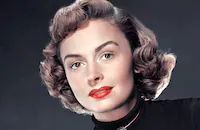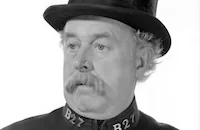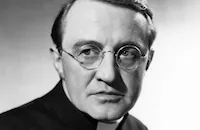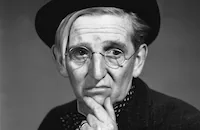The Picture of Dorian Gray

Brief Synopsis
Cast & Crew
Albert Lewin
George Sanders
Hurd Hatfield
Donna Reed
Angela Lansbury
Peter Lawford
Film Details
Technical Specs

Synopsis
In London in 1886, Lord Henry Wotton's curiosity is aroused when his friend, artist Basil Hallward, devotes his energies to painting the portrait of a beautiful young Adonis named Dorian Gray. Lord Henry, a cynical idle aristocrat who finds pleasure in manipulating the lives of others, takes an interest in Dorian, advising him that youth is all too fleeting and that the pursuit of desire is the only real goal in life. Lord Henry's words strike a chord in Dorian, and as Basil completes his portrait, Dorian declares that he would give his soul if the painting would grow old while he remained forever young. Lord Henry then cautions Dorian about making a wish in the presence of his Egyptian cat statue, a figure capable of granting it. Inspired by Lord Henry's sentiments, Dorian begins to seek new adventures, and one day wanders into a cheap music hall where he is smitten by singer Sibyl Vane. The idealistic Sibyl addresses Dorian as "Sir Tristam," the name of a mythical, chivalrous knight. When Dorian tells Sir Henry that he plans to marry Sibyl, whom he describes as an antidote to his cynicism, Lord Henry suggests that he test her integrity by inviting her to see the portrait and then asking her to spend the night. At first, Sibyl refuses Dorian's unseemly request, but unable to displease him, agrees to his terms. Disillusioned, Dorian writes Sibyl that she has killed his love and he will never see her again. Troubled by his cruelty, Dorian glances at the portrait and notices that the face has grown hardened, a reflection of his own soul. Vowing to reform, Dorian writes a letter begging Sibyl's forgiveness. Just as he finishes it, Lord Henry arrives to inform him that Sibyl has committed suicide. When Lord Henry advises Dorian to expunge the incident from his mind, Dorian's guilt prompts him to assume an air of indifference. Basil comes to the house to reproach Dorian for his unconcern and notes that the portrait has been concealed behind a screen. After Basil leaves, Dorian decides to lock the painting in his old schoolroom amid the souvenirs of his innocent childhood. As the years pass, rumors of Dorian's changeless youth and strange debauchery intensify. Periodically, Dorian scrutinizes his portrait, which has become disfigured by his sins and his aging. The only person to whom Dorian remains vulnerable is Basil's niece Gladys, who has loved him since she was a child. Over the objections of her suitor, David Stone, Gladys impetuously decides to propose to Dorian, but he rejects her offer. One foggy night, Basil, on his way to Paris, visits Dorian to ask him to deny the unremitting rumors about his wicked ways. In response, Dorian offers to show Basil his soul and takes him to view the portrait, by now a monstrous testament to his venality. Realizing that Basil might reveal his terrible secret to Gladys, Dorian plunges a knife into his back, causing fresh blood to appear on the painting. Afterward, Dorian arranges for Allen Campbell, a chemist over whom he has a sinister hold, to dispose of Basil's body. Dorian then proposes to Gladys and she accepts. Months pass as the police search in vain for Gladys' missing uncle. Then one day, the police notify Dorian that Campbell has committed suicide. Throughout the years, Sibyl's brother, James Vane, has sought the man responsible for his sister's death, the man he knows only as "Sir Tristam." One night, in a cheap pub, Vane hears Dorian called Sir Tristam and follows him into the alley, intending to slay him. Upon discovering that Dorian is a young man, Vane thinks he is mistaken until he later learns Dorian's strange story. Vane tracks Dorian to his country estate, and while hiding behind a clump of bushes, awaiting his chance to slay Dorian, Vane is accidentally shot and killed by a hunter. Realizing that he is indirectly responsible for Vane's death, Dorian decides to break his engagement to Gladys and returns to London. Believing that by destroying his portrait he will be free of its evil spell, Dorian plunges a knife into its heart. As the knife pierces the painting, Dorian falls to the floor, mortally wounded. While Dorian fervently prays, the portrait slowly changes into the image of a beautiful young man. Soon after, Lord Henry, Gladys and David burst into the room and find the hideously disfigured body of an old man lying on the floor.

Director

Albert Lewin
Cast

George Sanders

Hurd Hatfield

Donna Reed

Angela Lansbury

Peter Lawford

Lowell Gilmore
Richard Fraser

Douglas Walton
Morton Lowry

Miles Mander
Lydia Bilbrook
Mary Forbes
Robert Greig
Moyna Macgill

Billy Bevan
Renee Carson
Lillian Bond
Devi Dja

Sir Cedric Hardwicke

Reginald Owen
Lisa Carpenter
William Stack
Natalie Draper
Anita Bolster

Arthur Shields
James Aubrey
Charles Mcnaughton
Robert Cory
Alan Edmiston
Harry Adams
Norman Pogson
John Valentine
Charles Coleman
Carol Diane Keppler
Emily Massey
Sir Sydney Lawford
Mitchell Lewis
Frank Dawson
Leo Mostovoy
Joe Bernard

Jimmy Conlin

Bernard Gorcey
Taylor & Sinclair
Colin Campbell

Joe Yule
Guy Bates Post
Guy Bellis
Arthur Mulliner
Leonard Mellin
Craufurd Kent
Evan Thomas
Toby Doolan
Charles K. French
Eric Mayne
Major Sam Harris
William Holmes
Hugh Greenwood
Scott Seaton
Dick Earle
J. C. Fowler
Herbert Evans
Lillian Talbot
James Logan
John Good
Pedro De Cordoba
Pedro Regas

John George
Skelton Knaggs
Tom Pilkington

Kay Medford
Helena Benda
Tom Tamarez
Jerome St. John

Larry Williams
Frederic Worlock
Anne Curson
Renie Riano
Audrey Manners
Rex Evans
Edward Cooper
Kenneth Hunter
Lumsden Hare
Gibson Gowland
Lee Powell
Betty Fairfax
Harry Allen
Lotus Thompson
Glenna Kendall
Alice Keating
Margaret Roberts
T. Arthur Hughes
Al Ferguson
Bruce Carruthers
George Broughton
William Eddritt
Ila Lee
Doris Stone
Herberta Williams
Ann Lundeen
Helen O'hara
Reginald Simpson
Ruby Newport
Charles Knight
William O'brien
Wilson Benge
Sam Simone
Carl Leviness
Walter Rode
Tom Costello
Art Berry Sr.
Joseph Marievsky
Alex Pollard
Ray Flynn
Frank Mcclure
Leslie Sketchley
Eddie Aquilian
Buck Bucko
Pascale Perry
Alan Schute
Fred Aldrich
Whitey Sacks
Stuart Holmes
Donald Kerr
Wally Dean
George Jenner
Larry Stanton
Bud Harrison
Mike Jeffries
Lee Powell
Bill Patton
Frank Pharr
Paul De Corday
Oliver Cross
Ward Carson
Bob Maclean
Jack Lee
Mary Benoit
Volta Boyer
Elyse Brown
Monica Bannister
Olive Jones
Richard Collin
Kerry Vaughn
George Peters
Dorothy Ford
Barbara Woodell
Lorraine Miller
Lloyd Ford
Crew
Pop Arnold
Mel Ballerino
Edward Baravalle
Lew Barnes
Pandro S. Berman
John Bonar
Dick Borland
William Cary
Frank Caston
Earl Cates
Frédéric Chopin
Alberto Colombo
Murray Cutter
Eddie Davis
Mark Davis
Jack Dawn
William R. Edmondson
Cedric Gibbons
A. Arnold Gillespie
Don Hall
William Hargreaves
"duckie" Hendrickson
Ted Hoffman
Elmer Holtz
Hugh Hunt
Irene
Les Johnson
Harry Kearley
Joe Keener
Marion Herwood Keyes
Rudolph G. Kopp
Ethel La Blanche
Ivan Le Lorraine Albright
Sam Leavitt
Albert Lewin
Frank B. Mackenzie
Earl Mcevoy
M. J. Mclaughlin
Henrique Medina
Bob Meeker
C. W. Murphy
Frank Myers
Warren Newcombe
Dan O'brien
Tony Ordoqui
Hans Peters
Viola Pettit
C. A. Philbrick
Frank Phillips
Bernard Ponedel
Irving Richall
Rose Rockne
Jack Rohan
Bill Shaw
Douglas Shearer
Robert W. Shirley
Magdaline Simone
Newell Sparks
William Steinkamp
Michael Steinore
Herbert Stothart
Harry Stradling
Valles
Ferris Webster
Keith Weeks
Jack Wetzel
Gordon Wiles
Pasquale Williams
Edwin B. Willis

Photo Collections
Videos
Movie Clip





Trailer
Hosted Intro
Film Details
Technical Specs

Award Wins
Best Cinematography
Award Nominations
Best Art Direction
Best Supporting Actress
Articles
The Picture of Dorian Gray
Probably Oscar Wilde's most famous work, The Picture of Dorian Gray had been filmed at least seven times before writer-director Albert Lewin fashioned a lavish and effectively creepy version of it for MGM. There were some minor changes to the Wilde story such as the addition of a romantic subplot involving the niece of the painter (Donna Reed) and her fiance (Peter Lawford) and some censorship restrictions that kept Dorian's unspeakable acts offscreen. But the film was an artistic success, winning three Oscar nominations including Best Art Direction, Best Cinematography, and Best Supporting Actress Angela Lansbury in her third film, singing "Little Yellow Bird." Hurd Hatfield, in his second screen appearance, was so effectively evil in the title role that it actually handicapped his career with casting directors.
The real piece de resistance in The Picture of Dorian Gray is the hideous portrait which was painted by Ivan Le Lorraine Albright. He was hired after director Lewin saw a painting of his at the Art Institute of Chicago entitled That Which I Should Have Done I Did Not Do. In the film, Albright created four portraits showing Dorian's gradual dissolution and, in the final scene, where Dorian's true nature is revealed on canvas, the elegant black and white cinematography suddenly bursts into Technicolor, creating a startling effect. Equally memorable is a murder scene staged beneath a wildly swinging chain lamp, an effect that would be duplicated by Alfred Hitchcock in Psycho some fifteen years later.
Director: Albert Lewin
Producer: Pandro S. Berman
Screenplay: Albert Lewin
Cinematography: Harry Stradling
Art Direction: Cedric Gibbons, Hans Peters
Music: Herbert Stothart
Principal Cast: Hurd Hatfield (Dorian Gray), George Sanders (Lord Wotton), Angela Lansbury (Sibyl Vane), Donna Reed (Gladys Hallward), Peter Lawford (David Stone), Lowell Gilmore (Basil Hallward), Reginald Owen (Lord George Farmoor), Miles Mander (Sir Robert Bentley).
BW & C-111m. Closed captioning.
by Jeff Stafford

The Picture of Dorian Gray
The Picture of Dorian Gray - The Oscar®-Nominated 1945 Version is Finally on DVD
The Picture of Dorian Gray was a pet project for producer-director Albert Lewin. Lewin directed but six features yet his credits as a screenwriter stretch from the silent era to episodes of Diff'rent Strokes and The Facts of Life. A former English professor at the University of Missouri, Lewin broke into film as a reader for Samuel Goldwyn and worked his way up to the position of writer by 1924. The gestation period for his $2 million adaptation of Oscar Wilde's scandalous 1890 was slow; between being cast and filming her scenes, Angela Lansbury squeezed in roles in both Gaslight (1944) and National Velvet (1944). Early contenders for the pivotal role of Wilde surrogate Lord Henry Wotton were Basil Rathbone (an MGM contractee on loan to Universal for the Sherlock Holmes series) and Laird Cregar (who passed away before the film's premiere) before settling on Sanders, whose dry line readings and comportment of self-amusement made him the ideal candidate. Changing Wilde's conception of Dorian Gray considerably, Lewin handpicked Hollywood newbie Hurd Hatfield, whose only film role had been a small one in Dragonseed (1944). By all accounts, Lewin micromanaged Hatfield's every gesture (to the point of not letting the actor perform after four o'clock in the afternoon, for fear fatigue would show), resulting in a central performance that is appropriately strange but which never engages. One doesn't see what others see in this Dorian Gray, who seems as inflexible as mortician's wax even in his mysteriously protracted youth.
Its problematic central casting aside, The Picture of Dorian Gray still has much to offer. Lewin indulges in extended takes that allow his actors free range within the frame, showing off both the deep focus cinematography of Harry Stradling (who copped an Oscar® for his work) and the minutely realized (and Oscar®-nominated) art direction of Cedric Gibbons and Hans Peters. Not only is the film beautifully crafted but prophetic as well, with the emotionally stunted Dorian blazing a trail that would later be bloodied by the likes of Psycho's Norman Bates (they share a similar cobweb-strangled nursery and there is even an eerily prescient knife murder staged under a hanging lamp) and An American Psycho's Patrick Bateman (whose metrosexuality would not have been out-of-step in Victorian England). Additionally, the self-possessed Henry Wotton's slowly dawning conscience, by which he is able to appreciate that his teachings about aesthetics have inspired Dorian's diabolical disregard for others, anticipates the soul-sickening realization of James Stewart's Ivy League egghead in Rope (1948) that his teaching on intellectual superiority has bred monsters. Alfred Hitchcock's 1948 film adaptation of Patrick Hamilton's 1929 British stage play toned down the homosexual undertones of the story's teacher-student relationship but the source material feels as much inspired by Oscar Wilde as the Leopold and Loeb murder case on which it was purportedly based.
Without being the beneficiary of expensive restoration, The Picture of Dorian Gray looks good on this commemorative disc from this Warner Brothers Home Entertainment. While imperfections and blemishes in the source materials are sometimes present, the contrasts are sharp and the blacks satisfyingly deep. It's great to have the film's Technicolor inserts (for views of Ivan Albright's portraits of Dorian Gray, both before and after) back in the film, especially as those chromatics are so overwhelming and disturbingly saturated. The monaural sound is limited, to be sure, and sounds a bit on the quiet side for what is a largely subdued film, but is at least clean and noise-free. As far as supplements go, the highlight of the disc is an audio commentary shared by film historian Steve Haberman and surviving costar Angela Lansbury. Although Lansbury's character is in her grave by the film's halfway mark, Haberman proves himself a good master of ceremonies and Lansbury's insights into the making of the film are invaluable. For trivia hounds, it's revealed that Greta Garbo expressed an interest in cross-dressing to play Dorian Gray and that the pint-sized Lewin was known (derisively) as the Metro Gnome. Rounding out the roster of extras are the Oscar®-winning short Stairway to Light, the Academy Award®-winning Tom & Jerry cartoon Quiet Please!, as well a theatrical trailer.
For more information about The Picture of Dorian Gray, visit Warner Video.To order The Picture of Dorian Gray, go to TCM Shopping.
by Richard Harland Smith
The Picture of Dorian Gray - The Oscar®-Nominated 1945 Version is Finally on DVD
Quotes
I choose my friends carefully.- Lord Henry Wotton
Forgive me for the intelligence of my argument; I'd forgotten that you were a Member of Parliament.- Lord Henry Wotton
I like persons better than principles and persons with no principles better than anything at all.- Lord Henry Wotton
It's an odd thing, but every one who disappears is said to be seen at San Francisco. It must be a delightful city, and possess all the attractions of the next world.- Lord Henry Wotton
There's only one way to get rid of temptation, and that's to yield to it.- Lord Henry Wotton
"If I could get back my youth, I'd do anything in the world except get up early, take exercise or be respectable."- Lord Henry Wotton
Trivia
The movie is black and white except for four times when Dorian Gray's picture is shown in color.
Ivan Albright's famous painting of the decayed Dorian Gray - which took approximately one year to complete - is now owned by the Art Institute of Chicago. Albright's twin brother Malvin, better known as a sculptor, was also commissioned to create paintings for the film, although his work went unused.
The blocks under the table in Dorian's school room have the initials of the people who die.
Notes
Oscar Wilde's novel was first published in Lippincott's Lovely Magazine in July 1890. The following written verse from The Rubáiyát by Omar Khayyám opens and closes the film: "I sent my soul through the invisible, Some letter of that after-life to spell; And by and by my soul returned to me, And answered, "I myself am Heaven and Hell." In the picture, four scenes displaying Dorian's portrait are in color, the rest of the film is in black and white. Actress Renee Carson's name is misspelled in the onscreen credits as "Renie Carson."
Hollywood Reporter news items yield the following information about this production: Basil Rathbone and Herbert Marshall were first considered for the role of "Lord Henry Wotton." News items from 1943 add that Michael Dyne, Kenneth Donner, John Good and Robert Alton, Jr. were tested for the lead role. Although a November 1943 news item places June Lockhart in the cast, she does not appear in the released film. Other news items list Henry Burgess and Betsy Stoddard in the cast, but their appearance in the released film has not been confirmed. Moyna MacGill, who played the "Duchess," was Angela Lansbury's mother in real life.
According to modern sources, director Albert Lewin admired the work of painter Ivan Le Lorraine Albright and so commissioned him to paint four portraits showing the stages of Dorian's dissolution. Albright, who arrived in Los Angeles with his twin brother Malvin, also a painter, was paid $75,000 for the rights to the paintings. It is unclear whether Malvin helped his brother with the project. After creating the portrait of the ravaged Dorian, Albright fell behind and did not have time to complete the others. The studio then hired Henrique Medina to paint the picture of the young Dorian. According to M-G-M publicity items contained in the AMPAS Library, the statue of the Egyptian cat goddess in Dorian's living room was cast from the original in the St. Louis Art Museum. A modern source adds that Lewin created the character of "David Stone" so that the picture would have a happy ending.
The film received an Academy Award for Best Black and White Cinematography and was nominated for the following Academy Awards: Best Supporting Actress (Angela Lansbury), Best Art Direction and Best Set Direction. Among the many other adaptations of Oscar Wilde's novel are a 1910 Danish film; a 1913 New York Motion Picture Company two reeler, directed by M. Moore and starring Harris Gordon and Ernest Howard; and a 1970 international co-production titled Dorian Gray, directed by Massimo Dallamano and starring Helmut Berger and Richard Todd. On May 21, 1928, a play based on Wilde's novel titled Dorian Gray, directed by Augustus Thoren and starring Howard Cull and Lionel Adams opened in New York. Television versions include a December 6, 1961 CBS broadcast, directed by Paul Bogart and starring Sir Cedric Hardwicke and John Fraser, and a April 23, 1973 ABC version, directed by Glen Jordan and starring Shane Briant and Nigel Davenport.
















